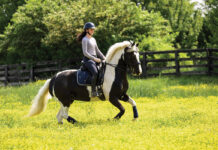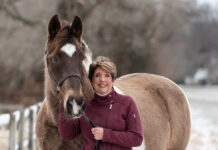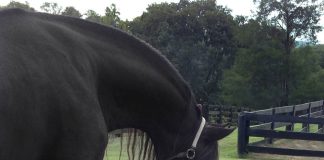
Twenty-seven was old for a horse, but aside from a slight sway to his back, March was looking pretty good for his age. He had to be kept separate from his herdmates, as they’d begun to bully him, especially at feeding time. Since his teeth were in poor condition, he ate very slowly.
Gentle Dental
I was gentle with his old jaws when I put the speculum into his mouth and opened it up, and I always sighed when I closed it again and unbuckled it from his head. March’s teeth looked worse every year, and there wasn’t a lot I could do about it.
Linnea, his owner would wet his senior feed a little so that it would not stick in his esophagus, the tube that connects the throat to the stomach. When a horse chokes on feed, he can still breathe, but due to the impaction in the esophagus, cannot drink or eat until it is relieved.
Although many chokes will clear on their own, a percentage need medical intervention. In severe cases the esophagus can rupture, which is usually fatal due to bacteria-laden fluids seeping into surrounding tissues.
Spotting Choke
A sure sign of choke is green, feed-smelling fluid bubbling from the horse’s nostrils and signs of discomfort, like pawing, lying down, head-shaking and depression.
March had choked several times in the past, and I had relieved the blockage by passing a stomach tube and gently flushing clean, warm water down to the feed mass until it broke free. I always sedated the horses heavily so that their heads would hang low because I did not want them aspirating on the fluids that were flowing from their nose as I worked to break down the impaction.
Wetting the feed had solved the problem with March, so when Linnea called one night, worried because March was not eating and seemed ill, choke was not on her mind. But what she was describing over the phone sure sounded like it to me.
March was depressed, refusing food and there was a wet discharge from both nostrils. Linnea insisted that he’d only had wet senior feed and his usual hay, and since there was no chewed hay in the discharge, what could he possibly be choking on? He’d been normal in the morning.
Farm Call
I quickly drove to the farm where poor March waited miserably in the barn aisle. His heart rate was 80—double the normal rate, and his gum color was an alarming murky red. He was panting, his temperature was 103, and I could hear no gut sounds. March was in trouble.
The nasal discharge was there, but it was mainly wet, so I sedated him lightly and performed a rectal exam. Aside from an empty gut, there wasn’t much out of the ordinary. An odorless pool of liquid had collected under his low hanging head, and I lubed up the stomach tube and carefully threaded it up his nostril and down into his esophagus. It passed easily until it reached the thorax, where the esophagus passes over the heart, then went no further. I’d found the problem, but what was causing it?
Gently I lavaged warm water into the esophagus and let it flow back out and little by little. Tan chunks of some sort of material washed out. Finally the tube passed into March’s stomach, and I gave him a good dose of electrolytes and warm water and a shot for pain.
Linnea and I studied the mess on the ground and suddenly we knew what it was. Wood shavings from March’s bedding! She shook her head in astonishment, then scolded her horse while hugging him gratefully. But we weren’t out of the woods yet.
With such a coarse impaction, I was worried about damage to the esophagus. Endoscopy was not in the budget, nor was hospitalization, so I did what I could and promised to see him early the next morning.
Re-Check
But he was worse when I arrived. His gums were dark red, his heart rate still 80, his temperature had climbed to 103.5 and he was shivering. He hadn’t touched his soft mash, and there was no manure in the stall.
I was now certain that his esophagus was ruptured, and in desperation I started some heavy antibiotics, adding in a new oral product that I hoped would soothe the damaged tissue, and I repeated the pain medicine. I called Linnea and let her know I’d be back to see him at lunch time.
I pulled up to the barn a little after noon and sat in my truck for a moment, dreading what I was going to find when I walked in. March had been such a big part of my practice, and I was going to miss his gentle presence.
I turned on the barn lights and strained to see March’s dark head in the row of stalls. As my eyes adjusted to the lights, I could see him standing quietly. His mash bucket was empty and there was a fresh, soft pile of manure on the ground.
Incredulously, I took his vitals and all were normal. His gum color was a healthy pink, and his gut sounds rumbled happily. He nosed my jacket while I called Linnea in a daze, and she cried with joy.
He stayed on the medicines for 10 days and remained happy and comfortable. I kept a sharp eye on his temperature and other vitals but they remained stable. Finally, he went back to his normal routine except for one major change: March is now bedded on straw.
Liked this article? Read past Vet Adventures columns:
Added Value
Caller on the Line
Pony Problems
COURTNEY S. DIEHL, DVM, has been an equine veterinarian since 2000. She resides in Steamboat Springs, Colo., where she is in private practice. Her first book, Horse Vet, Chronicles of a Mobile Veterinarian, was published in 2014. She is currently at work on her second book.
This article originally appeared in the August 2017 issue of Horse Illustrated magazine. Click here to subscribe!






